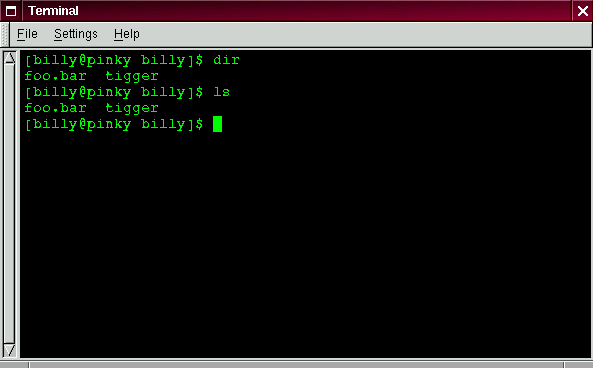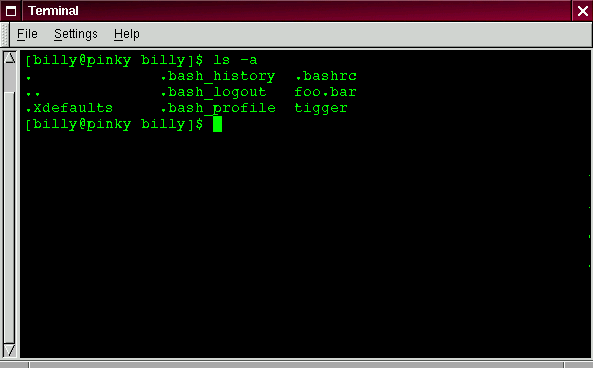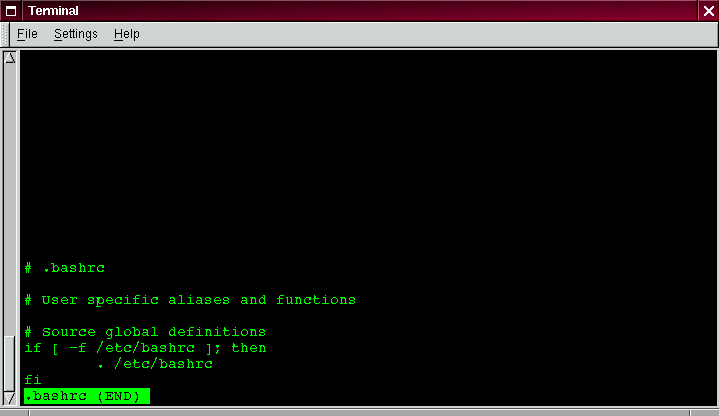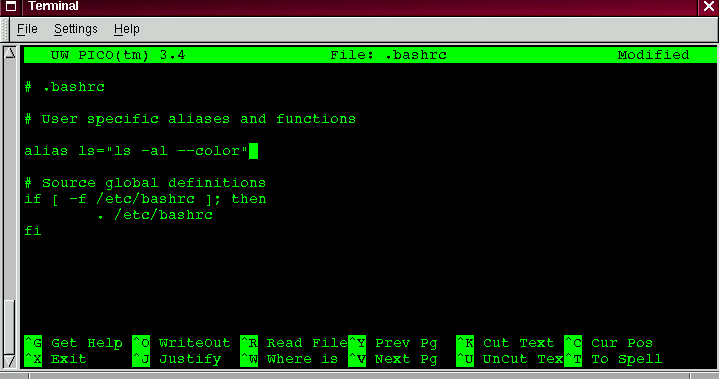You can start by creating an empty file. To do so, you can use a utility called touch at the shell prompt. Try it; type:
touch foo.bar
Now, in your login directory, you've got an empty file called foo.bar. You'll see it in a couple minutes.
Let's also create a new directory, using the mkdir command.
At the prompt, type:
Now, you've created a directory called tigger in your login
directory. From root, your new directory's absolute pathname would be
/home/yourlogin/tigger, and your directory is the parent of
tigger. (You can learn more about creating -- and removing -- files
and directories in Chapter 3.)
Now, you're ready to go.
In the DOS world, using the dir command will display the contents of
a directory.
The same can be said of Linux -- with some notable exceptions.
In Linux, dir won't fully display the contents of directories, and
doesn't have the power or flexibility of the list command -- ls.
In your login directory, for example, type:
Now, in the same xterm window, type:
Looks the same (see Figure 24). You see, among other contents,
your new file, foo.bar and the new directory, tigger.
But here the similarities end. Where dir shows you the contents of
your directory, it doesn't actually show you everything. Even using the
ls command, by itself, won't show you all the files in your
directory. To see everything, you've got to call upon an option or two.
For example, in the same window that you'd used to type the dir and
ls commands, now type:
Quite a difference. When you added the -a option, you were specifying
that you wanted to list all the files in the directory (see Figure
25).
In fact, there are a multitude of options available with the ls
command.
Why so many options? Because they can help you sort information according
to your needs. For example, you can specify how files are displayed, see
their permissions and much more.
When you typed ls -a, you probably noticed the files that begin with
dots. These are called hidden files or, appropriately enough,
dot files.
Hidden files are mostly configuration files which set preferences in
programs, window managers, shells and more. The reason they're ``hidden''
is to help prevent any accidental tampering by the user.
Whenever a filename starts with a dot (.), it's a hidden file, and ls
won't list it.
Viewing all the files can give you plenty of detail, but there's more you
can uncover, simply by adding more than one option.
If we want to see the size of a file or directory, when it was created and
more, we can just add the ``long'' option (-l) to our ls -a
command.
Try it. Type:
There's quite a bit more detail now. You can see the file creation date,
its size, ownership, permissions and more.
You don't have to be in the directory whose contents you want to view,
either.
Let's see what's in the /etc directory by typing:
Here, you'll get plenty of information about the contents of the
/etc directory.
If you want to add color to your listing, just include the --color
option.
To some, adding --color does more than add a splash of color; it
gives a clue about the types of files in a directory. For example,
directories might all be a royal blue, program files would be green, and so
on.
If you like what you see, here's how you can display the listing in color
all the time. Briefly, we'll be adding one line to the .bashrc file
in our login directory.
The .bashrc file is used by your shell when you login (an example
.bashrc file is shown in Figure 26).
Now before we go any further...
Remember that any changes you make to configuration files can cause you a
world of grief if you've made a mistake and you don't have a backup copy of
that file.
To make a backup copy, make sure you're in your login directory and in an
xterm window, type:
to get to your login directory. Then copy the .bashrc file, keeping
it in the same directory, but with a name like .bashrc2.
When you type the above command, what you're saying is, ``make a copy of
the .bashrc file and name that copy .bashrc2.''
Now, you have a backup copy of the unmodified .bashrc file in your
login directory. If you make a mistake or have trouble, you can replace
your .bashrc file by typing:
at the shell prompt.
If you need to type this command, you'll be saying, ``make a copy of the
file .bashrc2 and name that copy .bashrc.'' The copy command
here will overwrite the original .bashrc file -- and you'll still
keep a copy of the original (and untouched) .bashrc file with the
name of .bashrc2.
Now that we're prepared, we'll open .bashrc with Pico, a simplified
text editor. (A text editor is a utility program that can create
or modify files.) From an xterm window, type:
You should see something like this:
# User specific aliases and functions
# Source global definitions
if [ -f /etc/bashrc ]; then
. /etc/bashrc
fi
It's a pretty short file. Those hash marks (#) are
comments. Any text after them is ignored by the shell, but they
are put there to help guide anyone who's editing or modifying files.
Bring your cursor under the line #User specific aliases and
functions and type:
So the full file ought to look something like this:
# User specific aliases and functions
alias ls="ls -al --color"
# Source global definitions
if [ -f /etc/bashrc ]; then
. /etc/bashrc
fi
See Figure 27 for an example in Pico.
Double-check for any typos then, when you're satisfied with the changes,
exit by pressing the [Ctrl] and [X] keys. You'll see, at the bottom
of your editor screen, a message reading:
Press [Y] for ``yes.'' Now, another message will appear at the bottom:
Simply pressing [Enter] will save your changes to your .bashrc
file.
You won't be able to see your changes take effect until you close your
xterm window and open a new xterm. Once you do that, you'll see your
modifications take effect.
Here's a short list of some popular options with ls. Remember, you
can view the full list by reading the ls man page (man ls).
A little later in this chapter, when we introduce you to pipes
and I/O redirection, you'll discover that there are other ways to
view the contents of a directory.
mkdir tigger
dir
ls

ls -a

ls -al
ls -al /etc
ls -al --color /etc

cd
cp .bashrc .bashrc2
cp .bashrc2 .bashrc
pico .bashrc
# .bashrc
alias ls="ls -al --color"
# .bashrc

Save modified buffer (ANSWERING "No" WILL DESTROY CHANGES)?
File Name to write: .bashrc
![]()
![]()
![]()
![]()
![]()